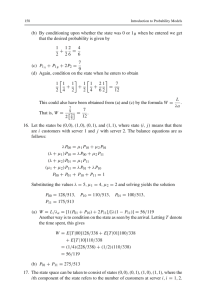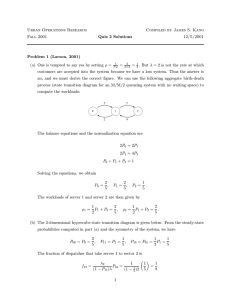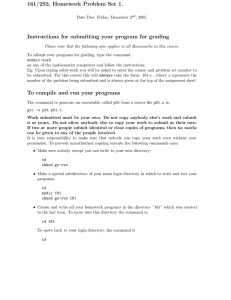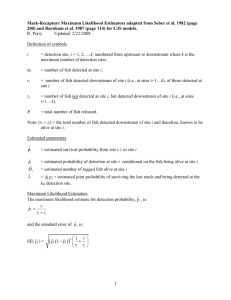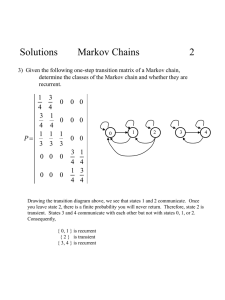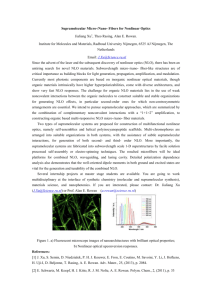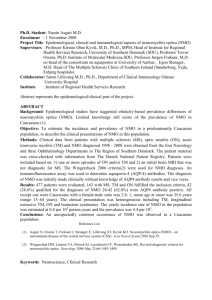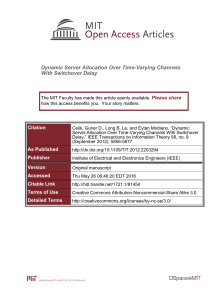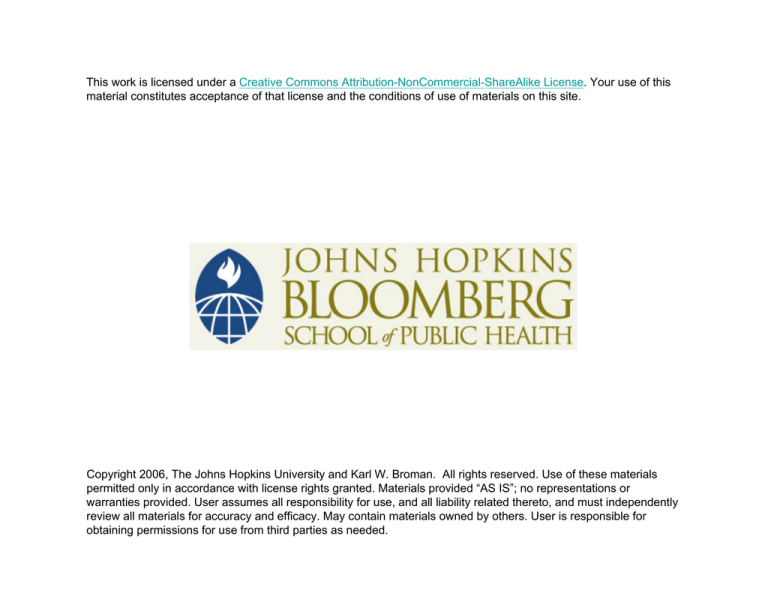
This work is licensed under a Creative Commons Attribution-NonCommercial-ShareAlike License. Your use of this
material constitutes acceptance of that license and the conditions of use of materials on this site.
Copyright 2006, The Johns Hopkins University and Karl W. Broman. All rights reserved. Use of these materials
permitted only in accordance with license rights granted. Materials provided “AS IS”; no representations or
warranties provided. User assumes all responsibility for use, and all liability related thereto, and must independently
review all materials for accuracy and efficacy. May contain materials owned by others. User is responsible for
obtaining permissions for use from third parties as needed.
2 x 2 tables
Apply a treatment to 20 mice
from strains A and B, and observe survival.
Gather 100 rats and determine whether they are infected with viruses A and B.
N Y
I-B NI-B
A
18 2
20
I-A
9
9
18
B
11 9
20
NI-A
20
62
82
29
71
100
29 11 40
Question: Are the survival
rates in the two strains the
same?
Question: Is infection with
virus A independent of infection with virus B?
Underlying probabilities
Underlying probabilities
Observed data
B
0
A
B
1
0
0
n00 n01 n0+
1
n10 n11 n1+
n+0 n+1
A
n
1
0
p00 p01 p0+
1
p10 p11 p1+
p+0 p+1
1
Model:
(n00, n01, n10, n11) ∼ multinomial( n, (p00, p01, p10, p11) )
or
n01 ∼ binomial(n0+, p01/p0+) and n11 ∼ binomial(n1+, p11/p1+)
Conditional probabilities
Underlying probabilities
B
0
A
Conditional probabilities
Pr(B = 1 | A = 0) = p01/p0+
1
Pr(B = 1 | A = 1) = p11/p1+
0
p00 p01 p0+
1
p10 p11 p1+
Pr(A = 1 | B = 0) = p10/p+0
p+0 p+1
Pr(A = 1 | B = 1) = p11/p+1
1
The questions in the two examples are the same!
They both concern:
p01/p0+ = p11/p1+
pij = pi+ × p+j for all i,j
Equivalently:
This is a “composite hypothesis”
2 x 2 table
B
0
A
1
0
p00 p01 p0+
1
p10 p11 p1+
p+0 p+1
H0 :
A different view
p00 p01 p10 p11
1
pij = pi+ × p+j for all i,j
H0 :
pij = pi+ × p+j for all i,j
degrees of freedom = 4 - 2 - 1 = 1
Expected counts
Expected counts
Observed data
B
0
A
B
1
0
0
n00 n01 n0+
1
n10 n11 n1+
n+0 n+1
A
1
0
e00 e01 n0+
1
e10 e11 n1+
n
n+0 n+1
n
To get the expected counts under the null hypothesis we:
1. Estimate p1+ and p+1 by n1+/n and n+1/n, respectively. (i.e.,
MLEs under H0.
2. Turn these into estimates of the pij.
3. Multiply these by the total sample size, n.
The expected counts
The expected count (assuming H0) for the “11” cell is the following:
e11 = n × p̂11
= n × p̂1+ × p̂+1
= n × (n1+/n) × (n+1/n)
= (n1+ × n+1)/n
The other cells are similar.
We can then calculate a χ2 or LRT statistic as before!
Example 1
Expected counts
Observed data
N Y
N
A
18 2
20
A
14.5 5.5 20
B
11 9
20
B
14.5 5.5 20
29 11 40
X2 =
Y
(18−14.5)2
14.5
29
2
2
11
40
2
14.5)
5.5)
5.5)
+ (11−
+ (2−5.5
+ (9−5.5
= 6.14
14.5
18
9
LRT stat = 2 × [18 log( 14.5
) + . . . + 9 log( 5.5
)] = 6.52
P-values (based on the asymptotic χ2(df = 1) approximation):
1.3% and 1.1%.
Example 2
Expected counts
Observed data
I-B NI-B
X2 =
I-B NI-B
I-A
9
9
18
I-A
5.2 12.8
18
NI-A
20
62
82
NI-A
23.8 58.2
82
29
71
100
(9−5.2)2
5.2
2
29
2
71
100
2
23.8)
12.8)
58.2)
+ (20−
+ (9−12.8
+ (62−
= 4.70
23.8
58.2
9
62
LRT stat = 2 × [9 log( 5.2
) + . . . + 62 log( 58.2
)] = 4.37
P-values (based on the asymptotic χ2(df = 1) approximation):
3.0% and 3.7%.
Fisher’s exact test
Observed data
N Y
A
18 2
20
B
11 9
20
29 11 40
• Assume the null hypothesis
(independence) is true.
• Constrain the marginal counts to
be as observed.
• What’s the chance of getting this
exact table?
Hypergeometric distribution
• Imagine an urn with K white balls and N – K black balls.
• Draw n balls without replacement.
• Let x = no. white balls in the sample.
• x follows a hypergeometric distribution
(with parameters K, N, and n.)
In urn
white black
sampled
x
n
not sampled
N–n
K
N–K
N
Hypergeometric probabilities
Suppose X ∼ hypergeometric(N, K, n).
[i.e., no. white balls in sample of n, without replacement from an
urn with K white and N – K black]
K N− K
Pr(X = x) =
x
n− x
N
n
Example:
N = 40, K = 29, n = 20
In urn
0
sampled
not
18
1
20
Pr(X = 18) =
20
29
18
40−29
20−18
40
20
29 11 40
The hypergeometric in R
dhyper(x, m, n, k)
phyper(q, m, n, k)
qhyper(p, m, n, k)
rhyper(nn, m, n, k)
In R, things are set up so that
m = no. white balls in urn
n = no. black balls in urn
k = no. balls sampled (without replacement)
x = no. white balls in sample
≈ 1.4%
Back to Fisher’s exact test
Observed data
N Y
A
18 2
20
B
11 9
20
29 11 40
• Assume the null hypothesis
(independence) is true.
• Constrain the marginal counts to be
as observed.
• Pr(observed table | H0) = Pr(X=18)
where X ∼ hypergeometric(N=40,
K=29, n=20)
Fisher’s exact test
1. For all possible tables (with the observed marginal counts), calculate the relevant hypergeometric probability.
2. Use that probability as a statistic.
3. P-value (for Fisher’s exact test of independence) = the sum of
the probabilities for all tables having a probability equal to or
smaller than that observed.
An illustration
The observed data
All possible tables (with these marginals):
N Y
A
18 2
20
B
11 9
20
29 11 40
20 0 → 0.00007
9 11
14 6 → 0.25994
15 5
19 1 → 0.00160
10 10
13 7 → 0.16246
16 4
18 2 → 0.01380
11 9
12 8 → 0.06212
17 3
17 3 → 0.06212
12 8
11 9 → 0.01380
18 2
16 4 → 0.16246
13 7
10 10 → 0.00160
19 1
15 5 → 0.25994
14 6
9 11 → 0.00007
20 0
Fisher’s exact test: Example 1
Observed data
N Y
P-value ≈ 3.1%
In R:
A
18 2
20
B
11 9
20
29 11 40
fisher.test()
Recall:
χ2 test:
LRT:
P-value = 1.3%
P-value = 1.1%
Fisher’s exact test: Example 2
P-value ≈ 4.4%
Observed data
I-B NI-B
I-A
9
9
18
NI-A
20
62
82
29
71
100
Recall:
χ2 test:
LRT:
P-value = 3.0%
P-value = 3.7%
Summary
Testing for independence in a 2 x 2 table:
• A special case of testing a composite hypothesis in a onedimensional table.
• Can use either the LRT or χ2 test, as before.
• Can also use Fisher’s exact test.
• I always prefer Fisher’s exact test.
Paired data
Underlying probabilities
Gather 100 rats and determine whether they are infected with viruses A and B.
B
0
I-B NI-B
A
I-A
9
9
18
NI-A
20
62
82
29
71
100
1
0
p00 p01 p0+
1
p10 p11 p1+
p+0 p+1
1
Another question: Is the rate of infection of virus A the same as
that of virus B?
In other words (ur...symbols): Is p1+ = p+1?
(Equivalently, is p10 = p01?)
McNemar’s Test
H0: p01 = p10
Under H0, the expected counts for cells 01 and 10 are both
(n01 + n10)/2.
(n01 − n10)2
The χ test statistic reduces to X =
n01 + n10
2
2
For large sample sizes, this statistic has null distribution that is
approximately a χ2(df = 1).
For the example: X2 = (20 – 9)2 / 29 = 4.17
−→
P = 4.1%.
An exact test
Condition on n01 + n10.
Under H0, n01 | n01 + n10
∼
binomial(n01 + n10, 1/2).
In R, use the function binom.test.
For the example, P = 6.1%.
Paired data
Paired data
Unpaired data
I-B NI-B
I
NI
I-A
9
9
18
A
18 82 100
NI-A
20
62
82
B
29 71 100
29
71
100
P = 6.1%
47 153 200
P = 9.5%
Taking appropriate account of the “pairing” is important!

